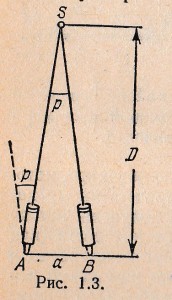In determining the distances to celestial bodies we can't perform direct measurements, and therefore for this purpose use various indirect methods. The most important is the method of trigonometric parallax.
If you look at any subject from different points (for example, on the tip of a pencil, alternately closing the left, the right eye), you will notice, that his situation on the background of more distant objects changes. The change of direction on the object while moving the observer is called parallax. The distance between the points, from which observation, called basis (in the considered example it is the distance between the eyes).
 By measuring the parallax, you can calculate the distance to a remote object. This principle is used in the rangefinder. In this device the base is the distance between the two lenses. Defining the angle p (rice. 1.3) between areas on the object S from the points A and b and knowing the basis AB=α, you can calculate the distance D to the object. Note, from that point, where the object is located S, basis visible angle R. The distance D to the object is much more of a basis α, and the angle p is always very small. If the baseline is perpendicular to the direction of an object, it can be taken equal to the arc length of a circle with radius D. Then α—DP, where the angle p is expressed in radians. Here
By measuring the parallax, you can calculate the distance to a remote object. This principle is used in the rangefinder. In this device the base is the distance between the two lenses. Defining the angle p (rice. 1.3) between areas on the object S from the points A and b and knowing the basis AB=α, you can calculate the distance D to the object. Note, from that point, where the object is located S, basis visible angle R. The distance D to the object is much more of a basis α, and the angle p is always very small. If the baseline is perpendicular to the direction of an object, it can be taken equal to the arc length of a circle with radius D. Then α—DP, where the angle p is expressed in radians. Here
D=α/р. (1.1)
By measuring parallaxes to calculate the distance of celestial bodies in astronomy. To measure the distance to a planet can determine its position against a background of stars simultaneously from two observatories, the distance between them will determine the basis. However, in practice it is much easier to make an observation from one Observatory at different times of the day, using the move of the Observatory during the rotation of the Earth around its axis. Measured in this way, the parallax for definiteness, we agreed to convert to same basis, equal to the radius of the globe.
In determining the distances to stars use the movement of the Earth in its orbit, because the distances are in this case too small, to serve as a basis. Using the telescope is usually photographing the same region of the sky with a period of six months. By measuring the offset of the selected star relative to more distant stars, determine parallax and calculate the distance to it. The basis in this case is the distance between two diametrically opposite points of the earth's orbit, from which observations were made. The measured parallax of stars have agreed to convert to same basis, equal to the major semiaxis of the earth's orbit (recall, that the Earth's orbit is an ellipse). Defined in this way is called annual parallax the parallax of a star. It is equal to the angle, which star is visible to the semimajor axis of earth's orbit, perpendicular to the direction of the star. If the angle p expressed in seconds of arc, it, since 1 rad=206265″, get:
П=206265α/p (1.2)
Substituting in (1.2) instead of α its value, it is possible to calculate, what is the annual parallax 1″ corresponds to the distance D =3,08*1016 m. This value is used in astronomy as a unit of length called the parsec(PC): 1PC=3,08*1016 m. The distance to stars in parsecs is equal to the inverse of its annual parallax, expressed in seconds of arc:
D = 1/p. (1.3)
Annual parallax of the nearest stars (alpha Centauri) was equal to 0,75″. The distance in parsecs D = (1/0,75) PC = 1,33 PC.






